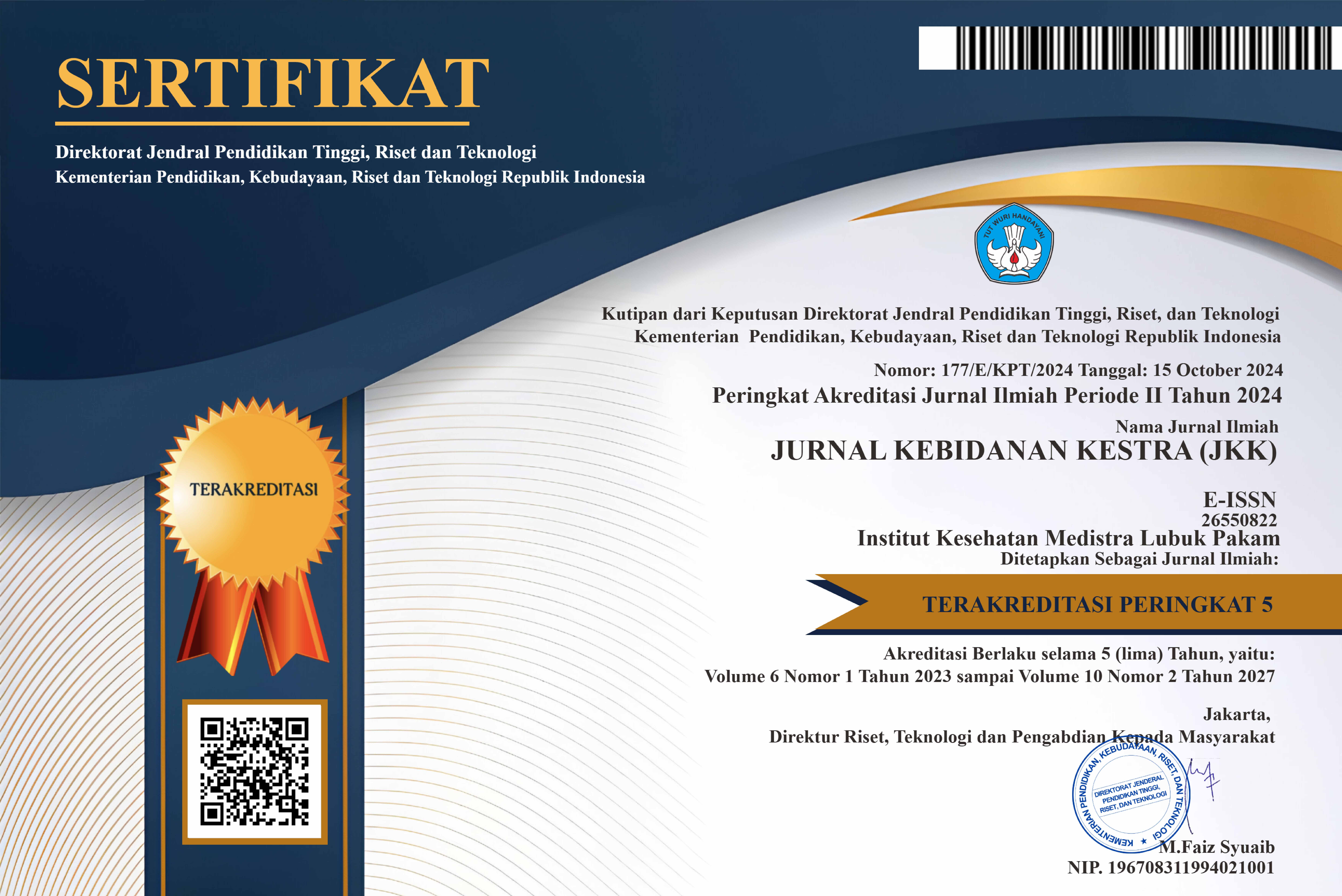Relationship Between Knowledge of Giving Warm Water Compresses to Prevent Breast Milk Retention in Postpartum Mothers
DOI:
https://doi.org/10.35451/jkk.v7i1.2357Keywords:
Breast Milk Dam, Warm Water Compress, Postpartum Mothers, Knowledge, PreventionAbstract
Breast milk dams are a common problem often experienced by postpartum mothers, which if not treated properly can cause pain, infection and obstacles in the breastfeeding process. One method that is known to be effective in preventing breast milk dams is by applying warm water compresses. This study aims to analyze the relationship between the level of knowledge of postpartum mothers regarding giving warm water compresses and preventing breast milk dams. This study used a cross-sectional design involving 60 postpartum mothers at the Juliana Clinic, Deli Serdang Regency, North Sumatra, Indonesia. Data was collected through a questionnaire that measured the mother's level of knowledge about warm water compresses and the incidence of breast milk dams. The results showed that the majority of mothers had sufficient (41.7%) and good (33.3%) knowledge about warm water compresses, while 25% of mothers had insufficient knowledge. As many as 58.3% of mothers did not experience breast milk dams, while the other 41.7% experienced breast milk dams. The results of the chi-square test showed that there was a significant relationship between postpartum mothers' knowledge about warm water compresses and prevention of breast milk dams (p-value < 0.05). Mothers with good knowledge experience breast milk dams less often than mothers who have less knowledge. In conclusion, good knowledge about warm water compresses has proven effective in preventing breast milk dams. More intensive education and counseling for postpartum mothers is needed to increase their knowledge about appropriate breast care techniques to prevent lactation problems.
Downloads
References
I. Yusita, M. Yuliani, and N. Hayati, “Manajemant Breast Engogerment Kompres Daun Kubis Dingin (Brassica Oleracea Var. Capitata) dan Breastcare terhadap Pembengkakan Payudara pada Ibu Nifas,” Jurnal Ilmiah Universitas Batanghari Jambi, vol. 24, no. 2, p. 1480, Jul. 2024, doi: 10.33087/jiubj.v24i2.4707.
T. P. K. Sari, K. Wijayanti, and M. C. Anwar, “The effectiveness of red ginger compress to prevent breast engorgement, reduce breast pain and prostaglandin hormone levels in postpartum mothers,” MEDISAINS, vol. 20, no. 2, p. 48, Sep. 2022, doi: 10.30595/medisains.v20i2.13587.
F. Agustina et al., “Lentera Perawat Application of Breast Care to Prevent Breast Milk Dams in Postpartum Mothers Penerapan Breast Care Untuk Mencegah Bendungan ASI Pada Ibu Post Partum,” 2024.
K. Maharani, A. J. Anggraeni, and Q. Qomariyah, “Efektivitas Pijat Payudara dan Kompres Air Hangat Terhadap Kecukupan ASI Bayi Pada Ibu Post Partum,” Jurnal Ilmu Kebidanan, vol. 7, no. 2, Jan. 2022, doi: 10.48092/jik.v7i2.132.
S. Wulandari, E. R. Yani, and F. I. Kundarti, “Differences in Postpartum Depression and Breast Milk Production in Postpartum Mothers After Implementing Postnatal Yoga,” EMBRIO, vol. 16, no. 1, pp. 71–78, May 2024, doi: 10.36456/embrio.v16i1.8171.
T. Novayanti Dey, D. Handayani, S. S. Bintang, and N. A. Azma, “HUBUNGAN PERAWATAN PAYUDARA DENGAN KEJADIAN BENDUNGAN (ENGORGEMENT) ASI PADA IBU NIFAS The Relation Between Breast Care And The Incidence Of Breast Milk Dams (Engorgement) In Postpartum Mothers,” 2022.
I. Oktaviani, S. Widiyas, and H. Anggranis, “Prosiding Simposium Nasional Multidisiplin ANALISIS IBU POSTPARTUM DENGAN BENDUNGAN ASI LITERATURE VIEW 1.” [Online]. Available: http://jurnal.umt.ac.id/index.php/senamu/index
N. Khaerunnisa, Hj. S. Saleha, and J. Inayah Sari, “MANAJEMEN ASUHAN KEBIDANAN PADA IBU NIFAS DENGAN BENDUNGAN ASI,” Jurnal Midwifery, vol. 3, no. 1, pp. 16–24, Feb. 2021, doi: 10.24252/jmw.v3i1.20992.
W. B. Sebayang and I. S. Ridwan, “EDUKASI PENANGANAN BENDUNGAN ASI PADA IBU POSTPARTUM DI KLINIK NANA DIANA HELVETIA MEDAN TAHUN 2021,” 2021. [Online]. Available: http://jurnal.uimedan.ac.id/index.php/Ji-SOMBA?6Journalhomepage:http://jurnal.uimedan.ac.id/index.php/Ji-SOMBA
N. B. Ginting Munthe, I. Markus Sembiring, R. Safitri, and S. Wulan, “PENGARUH PEMBERIAN DAUN BANGUN-BANGUN (COLEUS AMBONICUS LOUR) TERHADAP PRODUKSI ASI THE EFFECT OF GIVING LEAVES OF BANGUN-BANGUN (COLEUS AMBONICUS LOUR) ON BREAST MILK PRODUCTION,” 2021.
S. Ariandini, M. Kusmiati, N. Yusnia, and A. Rahmawati, “Faktor-faktor yang mempengaruhi bendungan ASI pada ibu nifas,” Journal of Public Health Innovation, vol. 3, no. 02, pp. 157–163, Jun. 2023, doi: 10.34305/jphi.v3i02.717.
J. Maternitas Aisyah Jurnal Maternitas Aisyah, P. Kusuma Wardani, M. Yolanda Umar, F. Kesehatan, and U. Aisyah Pringsewu, “HUBUNGAN TINGKAT PENGETAHUAN IBU NIFAS TENTANG PERAWATAN PAYUDARA DAN TEKNIK MENYUSUI DENGAN KEJADIAN BENDUNGAN ASI DI PMB MARTINI BANDAR LAMPUNG.” [Online]. Available: http://journal.aisyahuniversity.ac.id/index.php/Jaman
M. Laisouw, R. Malawat Program Studi D-III Kebidanan Ambon, and P. Kemenkes Maluku, “Juni 2022, halaman 36-43 Meilany Laisouw, Ratna Malawat Pentingnya Asuhan Kebidanan Komprehensif untuk Mencegah dan Mengatasi Bendungan.”
I. Oktaviani, S. Widiyas, and H. Anggranis, “Prosiding Simposium Nasional Multidisiplin ANALISIS IBU POSTPARTUM DENGAN BENDUNGAN ASI LITERATURE VIEW 1.” [Online]. Available: http://jurnal.umt.ac.id/index.php/senamu/index
I. Sari and B. Aquari, “Metode Breast care dalam Upaya Menstimulasi Keluarnya ASI Pada Ibu Nifas dengan Masalah Bendungan ASI,” JURNAL KESEHATAN TERAPAN, vol. 10, no. 2, pp. 9–14, Jul. 2023, doi: 10.54816/jk.v10i2.741.
M. T. Ekawati et al., “The Relationship Between Postpartum Mothers’ Knowledge About Breast Care and The Incidence of Breast Milk Dam in Postpartum Mothers Days 3-6 in The Bps Area.”
F. H. Alshakhs, N. E. Katooa, H. A. Badr, and H. A. Thabet, “The Effect of Alternating Application of Cold and Hot Compresses on Reduction of Breast Engorgement Among Lactating Mothers,” Cureus, Jan. 2024, doi: 10.7759/cureus.53134.
N. Yadav, H. Vyas, Mamta, and M. Goyal, “Effectiveness of prenatal lactation counseling on breastfeeding practices, breast engorgement, and newborn feeding behavior among postnatal mothers at a teaching institution,” J Family Med Prim Care, vol. 11, no. 3, pp. 1146–1151, Mar. 2022, doi: 10.4103/jfmpc.jfmpc_1217_21.
I. Sari and B. Aquari, “Metode Breast care dalam Upaya Menstimulasi Keluarnya ASI Pada Ibu Nifas dengan Masalah Bendungan ASI,” JURNAL KESEHATAN TERAPAN, vol. 10, no. 2, pp. 9–14, Jul. 2023, doi: 10.54816/jk.v10i2.741.
S. Ariandini, M. Kusmiati, N. Yusnia, and A. Rahmawati, “Faktor-faktor yang mempengaruhi bendungan ASI pada ibu nifas,” Journal of Public Health Innovation, vol. 3, no. 02, pp. 157–163, Jun. 2023, doi: 10.34305/jphi.v3i02.717.
Ayu Devita Citra Dewi and Bella Riska Ayu, “Edukasi tentang Cara Memerah ASI yang Tepat dan Kompres Hangat sebagai Penatalaksanaan Bendungan ASI,” Cakrawala: Jurnal Pengabdian Masyarakat Global, vol. 3, no. 2, pp. 217–222, May 2024, doi: 10.30640/cakrawala.v3i2.2648.
J. Kesehatan Bakti Tunas Husada et al., “REVIEW LITERATURE?: EFEKTIFITAS TINDAKAN SUPORTIF TERHADAP BENDUNGAN ASI PADA IBU POSTPARTUM.”
M. T. Ekawati et al., “The Relationship Between Postpartum Mothers’ Knowledge About Breast Care and The Incidence of Breast Milk Dam in Postpartum Mothers Days 3-6 in The Bps Area.”
Downloads
Published
Issue
Section
License
Copyright (c) 2024 Novita Br Ginting Munthe, Iskandar Markus Sembiring

This work is licensed under a Creative Commons Attribution 4.0 International License.
Copyright in each article is the property of the Author.



























